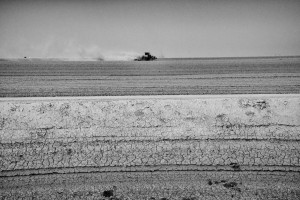Recently we looked at photographs from the era of the Great Depression and the work of FSA photographers such as Dorothea Lange and Walker Evans. The images illustrated how drought and wind storms transformed the Great Plains into the Dust Bowl. For the past several years, California has been experiencing bad drought conditions. Access to water has been drastically cut to California’s Central Valley, a main location of farms that provide Americans with fruit, vegetables and nuts. The documentary photographer Matt Black has documented the lives of farmers and the conditions of modern-day farms. Read a short article from The New Yorker and look through the photographs, then watch a short video that features interviews and Matt Black’s photographs. What do you think of these photographs in comparison to FSA photography? Why do you think so few Americans are aware of drought conditions in California and the impact on our agricultural supply?
Read The New Yorker article “The Dry Land” here
California: Paradise Burning video
Please submit your posts by Monday, December 15th.





These photographs like the photographs of the FSA show us the reality of what’s going on. No filters, no staged shots and if staged it was to dramatize the truth of whats happening. It is very sad that so many of us Americans are unaware of this drought that can and will or probably affected so many of us in the United States. Majority of our fruits and vegetables are grown in California. The land must be overworked and the government probably think they can easily fix the problem so it’s not greatly publicized as other problems we face now. Like the photographs from the FSA, these photographers used different filters to capture the full effect. Black and white makes the pictures seem more in depth and the land looks drier. On television commercials that advertise children and families in need the speaker is normally in color and the needy people are in black and white. It gets the attention of the viewer more being that things are normally seen in color for the common eye. Here the photographers draw you in and make you care and feel bad for whats going on as we should.